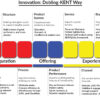
For small hospitals in today’s healthcare environment, there is a mighty challenges to be faced. Corporate hospitals are too big to compete on sprawling infrastructure, cutting-edge technology, and sheer marketing muscle. Going head-to-head competition in a saturated marketplace often results in smaller institutions being over-stretched and under-profiled. To coexist and prosper, smaller hospitals have to break away from competition on par and rethink how they add value.
The Blue Ocean Strategy of W. Chan Kim and Renée Mauborgne is a compelling framework. Of its major tools, the Four Actions Framework is a useful tool for recasting industry borders and discovering things untapped. By posing four critical questions—Eliminate, Reduce, Raise, and Create—a hospital can break free from imitation and create distinctive strategy that truly resonates among its people.
Understanding the Four Actions Framework
Four Actions Framework is a diagnostic and imaginative framework. It challenges the organizations to rethink assumptions driving competition and asks them to conceive a fresh “value curve” diverging from industry conventions.
The four critical questions are:
1. Eliminate: In what areas/sectors should factors taken for granted by the industry be erased?
2. Reduce: Reduced well below the standard of the industry what factors should be?
3. Raise: How to raise matters well above the standard of the industry?
4. Create: What factors should be developed that the industry never did?
For smaller hospitals, this framework becomes a lens in focusing on waste, diverting resources, and creating new strengths upon which corporate hospitals tend to look past.
Red Ocean of Hospital Competition
Competition in healthcare typically boils down to familiar variables: the newest technology, the greatest variety of specialties, high-end inpatient facilities, and celebrity consultant. Mega hospitals do well for the same reason on a smaller scale: economy of scale and size. Small hospitals are often forced to follow the same steps—spending to the hilt on expensive machinery, branching off into super-specialities, or redecorating wards to keep up appearances.
But few of these investments yield sustainable returns. Patients tend to link high-tech technology and sparkling facilities to established corporate hospitals. Therefore, small hospitals are at risk of being perceived as second-best competitors and not unique providers.
Four Actions of a Breakthrough Framework enables them to move out of this race, do what matters to their patient groups, and open untapped market space—the signature of a “blue ocean.”
Using Four Actions Framework within Small Hospitals
- Eliminate:
Small hospitals ought to find areas of waste on an attempt to be similar to major players. For instance:
• Overreliance on five-star style interiors, perhaps less important to patients caring about price and clinical results.
• Audio and video conventions and meetings with substantial costs and low visibility.
• Complicated administrative procedures costing money but contributing little to the patient.
By expunging such factors, smaller hospitals are able to unlock resources to reinvest on areas of real patient value.
2. Reduce:
The second step is to downsizing factors not requiring excessive investment. For example:
• Furnishing all possible speciality services may not be a requirement; concentrating on core specialities with maximum local demand can be more effective.
• Overdependency on consulting “star doctors” is likely to be expensive financially without generating lasting patient loyalty.
• Redundant Diagnostic procedures not strictly necessary or excessively forceful upselling of treatments, to wear down trust.
Minimizing these factors streamlines processes, saves money, and enables hospitals to be portrayed as less bloated and more efficient payers.
3. Rise:
Here is one of the greatest possibilities. Small hospitals can exceed on standards on parameters on which big hospitals tend to disappoint, for example:
• Patient experience: Reduced wait time, continuity of care, and accessibility of physicians.
• Trust transparency: providing straightforward, upfront pricing and frank talk.
• Integration with the community: adaptation to local cultural, linguistic, and societal environments.
• Responding to emergencies: being less slow and less rigid in emergency situations than big and rigid structures.
By elevating these factors beyond industry standards, little hospitals forge an intense emotional and practical connection with clients.
4. Create
Lastly, tiny hospitals are able to innovate through provision of fresh services hitherto avoided by the industry. Examples are:
• Preventive health programs: wellness clinics, routine check-ups, and way of life management
• Mobile health outreach: delivering care directly to proximal rural or underserved areas.
• Internet services: telemedicine services, tele-education services, and tele-entertainment services.
• Holistic care packages: combining physiotherapy, counselling, and rehabilitation and acute care.
Those innovations not only seduce new patient groups, but they also enhance reputation and loyalty.
A Practical Application
Take a semi-urban zone’s 100-bed hospital. It first tries to keep abreast of corporate rivals in investing in sophisticated oncology machinery. But after utilizing the Four Actions Framework, its executives make the following changes:
• Exclude luxurious interior and unnecessary advertising.
• Diminish its expansion of visiting consultants and super-specialties.
• Increase Patient accessibility, affordability, and emergency care response.
• Establish a telemedicine network of village to village, along with monthly preventive health camps.
This rebranding reshapes the hospital from a lagging imitator to a reputable community-focused institution with a loyal clientele.
Benefits of the Framework
- Strategic Distinction – Small hospitals can break away from “me-too.”
2. Resource Efficiency – Money goes to those things that matter to the patient.
3. Patient Loyalty – Trust becomes deeper when you show care and are transparent.
4. Sustainability – Growth becomes less subject to win-or-lose confrontations with big hospitals.
5. Clearness and Direction – The framework provides a unified direction for the administrators, physicians, and employees.
Challenges and Risks
Whereas mighty, the framework needs to be used cautiously. Small hospitals should also not underinvest in necessary safety or quality measures. Removing or shrinking the inappropriate factors may destroy credibility. Additionally, innovations need to be planned on real needs of the patient and not on assumptions. It needs to be done with constant interaction with the patient and community to justify decisions.
Final thoughts
The Four Actions Framework gives force to the thinking of small hospitals. Eliminating what doesn’t matter, streamlining what contributes to relatively low value, increasing what matters most to patients, and generating new offerings helps them re/title their value curve and create a unique identity for healthcare.
Rather than competing one on one with corporate hospitals in a busy red ocean, smaller hospitals can create their own map in a blue ocean—where competition is no longer a consideration and sustainable growth can occur.
As Kim and Mauborgne highlight, “Value innovation is the cornerstone of blue ocean strategy.” For smaller hospitals, adopting the Four Actions Framework is not mere survival—it is creation of a relevant future of trust and influence.
Dr. Prahlada N.B
MBBS (JJMMC), MS (PGIMER, Chandigarh).
MBA in Healthcare & Hospital Management (BITS, Pilani),
Postgraduate Certificate in Technology Leadership and Innovation (MIT, USA)
Executive Programme in Strategic Management (IIM, Lucknow)
Senior Management Programme in Healthcare Management (IIM, Kozhikode)
Advanced Certificate in AI for Digital Health and Imaging Program (IISc, Bengaluru).
Senior Professor and former Head,
Department of ENT-Head & Neck Surgery, Skull Base Surgery, Cochlear Implant Surgery.
Basaveshwara Medical College & Hospital, Chitradurga, Karnataka, India.
My Vision: I don’t want to be a genius. I want to be a person with a bundle of experience.
My Mission: Help others achieve their life’s objectives in my presence or absence!
My Values: Creating value for others.
Leave a reply
















Dear Dr. Prahlada N.B Sir,
Your post on the *Four Actions Framework* is truly enlightening, offering valuable insights for small hospitals to break away from competition and create their own *blue ocean.* By eliminating unnecessary factors, reducing waste, raising patient-centric services, and creating innovative offerings, small hospitals can differentiate themselves and achieve sustainable growth.
Your practical application example demonstrates how this framework can be effectively implemented, and the benefits are clear : *strategic distinction, resource efficiency, patient loyalty, sustainability, and unified direction.*
Thank you for sharing your expertise and experience. *Your work is inspiring and will undoubtedly help small hospitals improve their services and care for patients.*
Reply